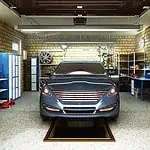There are two fundamental light roles in any space: utility and aesthetics. You can achieve both by following the right techniques and using the right fixtures for a space. While lighting a school, following the right technique and using the correct fixtures is extremely important. Going wrong with either of these things can compromise the utility and thus render the lighting useless. However, you have nothing to worry about as we will explain everything there is to know about school lighting in this guide. So, let’s get to it.
What Exactly Is School Lighting and Why Does It Matter?
From the two fundamental roles of lights, utility is particularly important when it comes to school lights. It impacts the room’s visibility and students’ mood, which is an important consideration in any teaching facility. Poor lighting conditions can cause glare and reflections, which can fatigue the students and reduce their concentration in class. In contrast, an ideal lighting environment will enhance the students’ mood and increase their productivity.
Proper LED lighting will reduce glare and conceal reflection. Thus, students will not experience any strain or fatigue in the eyes, allowing them to focus better and learn more. Furthermore, light temperatures also play a significant role. Lights that are warm produce drowsiness and diminish the focus of students. It is because warm lights trigger melatonin production in the body, a sleep hormone that produces drowsiness.
On the other hand, cool lights mimic natural light and stop the production of melatonin, making the body feel more active and energetic. It helps improve students’ focus and makes them sharper in class.
In a nutshell, school lighting can impact everything ranging from a class’s overall environment to students’ academic performance. Thus, it is very important to do it right.

Importance of LED Lights In School Lighting
Schools use different types of lights in their outer spaces and classrooms, but few options are just as good as the LED lights. Let’s take a look at some of the reasons which make LED lights very important in school settings;
Energy-Efficient
LEDs cost more upfront but are still the most cost and energy efficient than other options. You cannot afford to install an energy-draining solution in the school because it will increase the energy bills by many folds. Typically, schools use incandescent bulbs, which are not just not durable but also consume far more energy. To put things in perspective, incandescent bulbs use about 75% more energy than LEDs. Imagine how much you will save on energy bills by opting for LEDs.
Furthermore, LEDs are much more durable than incandescent bulbs, so you would not have to replace them often. Once you have installed them in the school, you are good for at least a few years. And it is crucial for schools as changing the bulbs during class can break the tempo and disturb the learning process.
Improves Classroom Performance
Some schools prefer fluorescent lights because of unfiltered illumination, but it is counter-productive. While it may improve the brightness in the room, it will also disturb the normal circadian rhythm and lead to a number of health issues. Light coming from fluorescent fixtures can cause glare and lead to vision loss, distractions, hyperactivity, loss of concentration, and blood pressure spikes, among other things.
On the other hand, LEDs do not produce any of these problems and allow the school to tailor their lighting needs as per requirements. For example, schools can choose cool lights in spaces where students have to concentrate and warm places where students can relax.
Reduces Light Sensitivity
The inability to control the motions of the eyes with respect to the light source can impair vision, a condition known as light sensitivity. Such problems arise when the beam angle of the light is not right. The symptoms of light sensitivity include double vision, eye redness, blurred vision, migraine, cluster headache, and extended blinking periods. If the students in school are experiencing any of these symptoms, the school lights need to be redesigned. The best way to avoid these problems is to use LEDs.
Decreases Stress Levels
One of the goals of school lighting is to prevent or reduce stress levels in students. Traditional lights, such as fluorescent bulbs, upregulate the level of cortisol, a stress hormone, and impact students’ stress levels. It can affect various issues, from blood sugar levels to sleep cycles. Using LEDs will help you manage the physical and mental stress of students.
Reduces Long-Term Eye Risk
Exposure to traditional lights for long durations can lead to a multitude of eye problems. These include cataracts, macular degeneration, and corneal bumps. However, using LEDs as a light source can prevent all of these problems.

Things To Consider For School Lighting
Now that you understand the importance of school lights, let’s take a look at things you should consider before lighting a school.
Luminance Contrast
Luminance contrast is vital to understand while lighting a school’s classrooms. There are different objects in a classroom in a range of colors. Not all colors will reflect similarly. For example, darker colors absorb light and reflect less, and vice versa. So, the difference between the reflection of light emitting from the darkest object or area and the lightest object or area is the luminance contrast.
It is important because it impacts the class’s view of whiteboards and blackboards. You should try to keep it between 5-20% if the class has a blackboard and keep it above 70% if the class has a whiteboard. The rest of the class should have a luminance of around 25-40% to create a comfortable environment.
Color Temperature
The color temperature of lights is measured on the Kelvin scale, which ranges between 1,000 to 10,000. Each figure on the scale represents the color of light that a source will emit. For example, LEDs under 3,000K emit warm light, which offers reddish and yellowish hues. Similarly, LEDs with a more than 4,000K temperature emit cool light that mimics daylight.
The color temperature affects the human body the same way as the night and day change. During the night, when there is little to no light, human bodies start to produce melatonin, a hormone responsible for triggering sleep. However, during the day, there is no production of this hormone which keeps the body energetic and motivated.
Light temperature similarly impacts the body. Students will experience drowsiness if the classroom has cool colors because of yellow or bright hues. However, if the light temperature exceeds 4,000K, students will feel more focused and concentrated.
CRI
Have you ever wondered why some objects have different indoor and outdoor appearances? It is because there is a difference in color rendering in artificial and natural light, which is what the color rendering index measures. LEDs with a CRI of more than 80% will make the objects look the same as they look in natural light. However, those that have lower CRI will render the color differently than natural light. You would want to keep the classroom environment as close to natural light as possible. Thus, try to get LEDs that have a CRI of more than 80%.
Uniform Distribution
Each part of the classroom should receive an equal amount of light from the source. You can achieve it by using different types of fixtures. The selection of appropriate fixtures will depend on the room’s area and the lights’ location. Fixtures that distribute light uniformly include linear LED, Flat Panels, and Vapor Tight, among others. You can ensure light uniformity in classrooms by ensuring the lux rating is around 500. Furthermore, all corners of classrooms should receive the same intensity of light. Typically, 60-70% illumination works best for most classrooms.
Object and Face Modeling
Object and Face modeling is vital for classroom lights because students and teachers have to read the lips of each other to communicate effectively. Whatever technique or fixture you use should ensure that students and teachers can see each other clearly without any glare. Furthermore, you can also create different patterns to create depth between the teacher and the black/whiteboard. It will help students see both the black/whiteboard and teachers’ facial expressions.
You can achieve it by keeping the reflection of lights undiffused. Otherwise, it will make the faces and objects look flat and dull.
Light Glare
Glare is the single factor that can render the entire lighting of a school and classroom useless. You should ensure that fixtures or the techniques you use do not produce any glare to prevent straining the students’ eyes. The standard glare rating is around 19, but it can be decreased or increased based on the utility of space. For example, corridors can have a higher rating, but they should remain under 19 for light-sensitive tasks. You can use anti-glare LEDs to prevent this problem altogether.

How To Light School Appropriately
By now, you should know everything there is to know about school lighting. Now you only need to figure out the right steps to illuminate the school effectively. The first thing you should do is identify each area’s lighting requirements. It will help narrow down the wattage and the number of fixtures needed for different places in the schools. While identifying the lighting requirements, do not forget to consider the color of the interior and boards.
The second step is to find the right places for fixtures so they can distribute the light evenly throughout the classroom. Based on the dimensions of classrooms, find the appropriate fixtures. Then, select the appropriate color temperature, CRI, and light source wattage based on the requirements. Find the correct light types, but as discussed, there are no better options than LEDs. You will get LEDs in all shapes, colors, and sizes. Using a combination of different LEDs will deliver the best results.
Be mindful that lighting a school is tricky, and you should not do it alone. Hire an electrician to reduce the chances of errors and ensure the safety of students and teachers.
FAQs
LED lighting is the best for schools because it consumes less energy and lasts much longer than traditional bulbs. Furthermore, the market offers a range of LEDs in different colors, shapes, and sizes, allowing you to illuminate the area perfectly.
Light is important in schools for two reasons; utility and impact on mood. Students will not see things clearly without adequate lighting, which compromises their education. Furthermore, the light also impacts the mood. Inadequate lighting will make the students feel drowsy and lose focus, reducing attention span and costing important educational pieces.
The appropriate lighting level for young students is 300 lux and 500 lux for adult students.
Schools should use lights with a color temperature of 5,000K to increase the focus and concentration of students. Such light colors produce daylight-type light that stops melatonin production and does not make the students feel drowsy.
Lighting has a significant influence on the moods of students. A bright light will make them more alert and allow them to focus better on what is being taught. In contrast, a dull light will make the students feel drowsy and lose their concentration on subjects.
Conclusion
Appropriately lighting a school and classroom is very important, but the process is quite tricky. You need to consider several factors to create a suitable environment for learning. The most important of them is the selection of a light source, and LEDs are the most suitable solution in the market. Furthermore, you must also understand different types of fixtures and how they project light from them to illuminate the area properly. We hope the guide has helped you with all of these aspects.
LEDYi manufactures high-quality LED strips and LED neon flex. All of our products go through high-tech laboratories to ensure the utmost quality. Besides, we offer customizable options on our LED strips and neon flex. So, for premium LED strip and LED neon flex, contact LEDYi ASAP!












